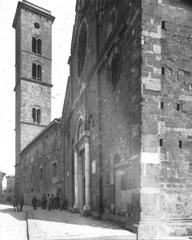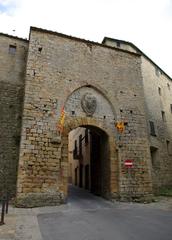Porta Marcoli: Visiting Hours, Tickets, and Historical Insights for Volterra
Date: 14/06/2025
Introduction
Porta Marcoli is a remarkable yet often overlooked gateway in the ancient city walls of Volterra, Tuscany. As one of the city’s historic entrances, it encapsulates the evolution of Volterra from its Etruscan roots through medieval times. This detailed guide provides everything you need to plan your visit, including historical context, architectural features, cultural significance, visitor information, and practical tips for exploring both Porta Marcoli and Volterra’s other heritage sites. Whether you are a history enthusiast, architecture lover, or a curious traveler, Porta Marcoli offers a peaceful and meaningful connection to Tuscany’s enduring past.
Table of Contents
- Introduction
- Historical Context of Porta Marcoli
- Architectural Features
- Cultural and Religious Significance
- Preservation and Current State
- Practical Visitor Information
- Travel Tips for Visiting Porta Marcoli
- Notable Nearby Sites
- Architectural Comparison with Other Gates
- Frequently Asked Questions (FAQ)
- Conclusion and Call to Action
- References and Further Reading
Historical Context of Porta Marcoli
Volterra, known in antiquity as Velathri, is renowned for its extensive Etruscan heritage, with city walls dating back to the 4th century BCE. Porta Marcoli, while not as famous as the monumental Porta all’Arco or Porta Diana, stands as a testament to the city’s layered history. Its original function was both practical and strategic, controlling access to the city and serving as a vital link between Volterra and the nearby Olivetan monastery of Sant’Andrea. Over centuries, the gate witnessed the transformation of Volterra through Etruscan, Roman, and medieval periods, surviving conflicts, urban expansion, and changes in governance (mamaisonservices.com; ipanematravels.com; italian-traditions.com).
During the Middle Ages, the city’s fortifications were reinforced, and gates like Porta Marcoli were adapted to meet new defensive needs. The gate’s strategic placement enabled it to monitor movement in and out of the city, while also facilitating religious and social interactions with the monastery (mamaisonservices.com).
Architectural Features
Porta Marcoli is a fine example of medieval Tuscan military architecture. Built primarily with local stone, its modest archway was designed for functionality and defense rather than grandeur. The gate likely featured heavy wooden doors and may have once been equipped with a portcullis. The surrounding walls, rising up to 11 meters, exemplify the robust fortification methods of the time. Unlike the more ornate Etruscan gates, Porta Marcoli’s design is utilitarian, with minimal ornamentation and a focus on durability (ipanematravels.com).
The visible differences in masonry around the gate indicate various phases of construction and restoration, reflecting the gate’s adaptation to changing defensive needs and historical circumstances (mamaisonservices.com).
Cultural and Religious Significance
Porta Marcoli’s proximity to the Olivetan monastery of Sant’Andrea underscores its spiritual and social relevance in Volterra’s history. The gate facilitated the movement of monks and the faithful, playing a part in religious processions and charitable activities. Historically, each of Volterra’s gates contributed to the city’s identity and autonomy, often associated with specific trades, neighborhoods, or religious institutions (ipanematravels.com).
Preservation and Current State
Today, Porta Marcoli remains a quietly dignified presence in Volterra’s historic landscape. While less frequented than other city entrances, it offers visitors a chance to experience the tranquility and authenticity of medieval Volterra. The gate and its adjoining walls have benefited from ongoing preservation efforts by local authorities, ensuring their stability and accessibility. Restoration projects have revealed the layers of history embedded in the stonework, allowing visitors to appreciate Volterra’s continuous urban evolution (mamaisonservices.com; ipanematravels.com).
Practical Visitor Information
Visiting Hours
- Porta Marcoli is an open-air monument and accessible 24 hours a day. For safety and optimal viewing, visits during daylight hours (sunrise to sunset) are recommended (The Discoveries Of).
Tickets
- No ticket or admission fee is required to visit Porta Marcoli. The gate is freely accessible as part of Volterra’s public city walls.
Accessibility
- The approach to Porta Marcoli involves cobbled and occasionally uneven surfaces, which may present challenges for visitors with mobility impairments. There are no ramps or handrails at the site. Those with limited mobility should consider visiting with a companion or focusing on more accessible areas of Volterra (thegeographicalcure.com).
Getting There
- Porta Marcoli is located on the eastern side of Volterra’s historic center. From main squares like Piazza dei Priori, it is a short and scenic walk. The nearest parking areas are Parcheggio Docciola and Parcheggio La Dogana. Follow pedestrian signs from the parking lots to the city walls and Porta Marcoli (The Discoveries Of).
Travel Tips for Visiting Porta Marcoli
- Combine your visit to Porta Marcoli with other historic sites such as the Roman Theatre, Museo Etrusco Guarnacci, and Porta all’Arco for a comprehensive tour of Volterra’s ancient defenses (ipanematravels.com).
- Best times to visit are early morning or late afternoon for beautiful light and fewer crowds.
- Join a guided tour or use a digital audio guide like the Audiala app for deeper historical context.
- Wear comfortable shoes due to uneven terrain and cobblestones.
- Photography opportunities abound, especially with the interplay of stone and Tuscan landscape.
Notable Nearby Sites
- Olivetan Monastery of Sant’Andrea: Historical site adjacent to the gate, reflecting Porta Marcoli’s religious significance (mamaisonservices.com).
- Museo Etrusco Guarnacci: A short walk away, housing Etruscan artifacts (mapcarta.com).
- Roman Theatre: Within walking distance and often included in city tours (ipanematravels.com).
- Piazza dei Priori: The city’s medieval heart, filled with vibrant cafes and architectural gems.
Architectural Comparison with Other Gates
While Porta Marcoli is modest and utilitarian, other gates like Porta all’Arco and Porta Diana showcase the grandeur of Etruscan and Roman architecture with monumental arches and decorative stonework. Porta Marcoli’s simplicity highlights the city’s shift towards practical medieval defenses, marking the evolution of Volterra’s urban design (mamaisonservices.com).
Frequently Asked Questions (FAQ)
Q: Are tickets required to visit Porta Marcoli?
A: No, there is no admission fee; the gate is freely accessible to the public.
Q: What are the visiting hours?
A: Porta Marcoli is accessible 24/7, but daylight hours are recommended for safety and enjoyment.
Q: Is the gate wheelchair accessible?
A: The area has cobblestone and uneven paths, which may be difficult for wheelchair users. Plan accordingly.
Q: Are guided tours available?
A: While not always included in standard tours, private guides and custom walking tours can feature Porta Marcoli. Inquire at the Volterra tourist office.
Q: Can I combine Porta Marcoli with visits to other attractions?
A: Absolutely. The gate’s location makes it easy to include in itineraries featuring the Roman Theatre, Museo Etrusco Guarnacci, and other city landmarks.
Conclusion and Call to Action
Porta Marcoli is a quietly evocative gateway into Volterra’s rich medieval and Etruscan legacy. Its understated architecture, accessibility, and peaceful atmosphere make it an ideal destination for travelers seeking to immerse themselves in authentic Tuscan history. Plan your visit to Porta Marcoli as part of a wider exploration of Volterra’s ancient walls and vibrant culture. Use the Audiala app for self-guided tours, stay updated on local events, and support the preservation of this remarkable heritage site by practicing responsible tourism.
References and Further Reading
- Cities with Historic Walls to Visit in Tuscany – Mamaisonservices.com
- Attractions to Visit in Volterra, Tuscany, Italy – Ipanematravels.com
- Volterra Travel Guide – Volterra.net
- Volterra Italy Travel Guide – The Discoveries Of
- Volterra – Terre di Pisa
- Volterra Travel Guide – To Tuscany
- One Day in Volterra Itinerary – The Geographical Cure
- Museo Etrusco Guarnacci – Mapcarta
- Best Museums in Volterra – WhichMuseum
- Volterra la città fondata dagli Etruschi – Italian Traditions

